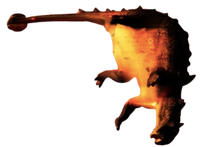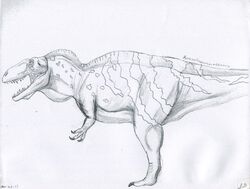l

| Acrocanthosaurus Temporal range: Early Cretaceous | |
|---|---|

| |
| An Gabriel Ugato's illustration of Acrocanthosaurus atokensis | |
| Scientific classification | |
| Kingdom: | Animalia |
| Phylum: | Chordata |
| Clade: | Dinosauria |
| Order: | Saurischia |
| Suborder: | Theropoda |
| Family: | †Carcharodontosauridae |
| Genus: | †Acrocanthosaurus Stovall & Langston, 1950 |
| Species: | †A. atokensis |
| Binomial name | |
| Acrocanthosaurus atokensis Stovall & Langston, 1950 | |
| Synonyms | |
| |
Acrocanthosaurus ( meaning high-spined lizard ) is a genus of large carcharodonotosaurid theropod dinosaur from North America during the Early Cretaceous Period about 112 million years ago. The type and only species of this genus is A. atokensis.
Discovery[]
In 1950, a team of scientists, led by paleontologists J. Willis Stovall and Wann Langston, Jr, was excavating in the deserts of Oklahoma when they came across very large fossilized bones and tall vertebrae. They were taken to a nearby museum and were found to belong to a new species of very large theropod dinosaur. It wasn't long afterward that it was officially named Acrocanthosaurus atokensis, or "Atoka's high-spined lizard", after the tall spines along its back and the area in Oklahoma where it was first found. However, it was first discovered in 1940s but hadn't gained any attention until its rediscovery a decade later. Since then, several more Acrocanthosaurus specimens have been found, and even a very well preserved fossil trackway of it chasing down a Sauroposeidon.
The genus has been discovered in several states along the western half of America, including Oklahoma, Texas, Wyoming, Arizona, and even as far east as Maryland, suggesting Acrocanthosaurus was a very widespread and successful predator during its time. And in 2012, the pubic bones, vertebrae, and fibula of a juvenile Acrocanthosaurus were found in the Cloverly Formation in Wyoming, suggesting this theropod was the only large predator in this formation during the time of the dinosaurs.
Description[]
Acrocanthosaurus was a large carnivorous theropod that had a large roughly triangular head, numerous sharp serrated teeth, strong forelimbs, and powerful hind legs. It lived alongside the small raptor Deinonychus, some small ankylosaurs, and hunted large sauropods. Acrocanthosaurus had one feature that distinguished it from other theropods; the tall neural spine which ran along its neck, back, and tail.

Acrocanthosaurus skeletal reconstruction by Franoys
Some of these spines were over a foot tall. It may represent an evolutionary link between the Late Jurassic Allosaurus and the gigantic Early Cretaceous Carcharodontosaurus. It was one of the largest bipedal carnivorous dinosaurs, with one mounted specimen reaching a length of possibly 11.5 meters (38 feet) and an estimated weight of 5 to 6 tonnes. Many of its vertebrae had high neural spines, though nowhere as high as those of Spinosaurus.
Scientists have debated why Acrocanthosaurus had a sail or a ridge along its back. Some think it released heat when the animal was too hot. It also may have been used for display to make the animal look bigger when it faced rivals for territories or mates. This is much like a house cat fluffing up its fur and arching its back to make itself look bigger. There are other large tall-spined dinosaurs from Europe and Africa, but scientists don't know why Acrocanthosaurus had it. An interesting take on the usage of Acrocanthosaurus' sail was as a technique of hunting prey. It is possible that the tall vertebral spines were attachment points for strong muscles, providing a great form of anchorage for the neck while the animal attacked large prey.

An innacurate reconstruction of Acrocanthosaurus. Credit: Isreal B.
Acrocanthosaurus was an early carcharodontisaurid with an exceptionally large sail. Acrocathosaurus is estimated to be 5-7 metric tons (most reliable estimate being 5.8 metric tons), 11-12 meters long, and 3 meters tall at the hip.
Scientists have found footprints probably made by Acrocanthosaurus in several places in Texas. In one place, it looks like an Acrocanthosaurus stalked a large sauropod across a mud flat, possibly Sauroposeidon. When the sauropod footprints changed direction, so did those of Acrocanthosaurus. The outcome of this discovery shows that the Acrocanthosaurus' jaws were hanging onto one of the thighs of the sauropod while the it was running.
A study in 2021 estimated a bite force of 17651 Newtons (~1.765 tonnes) for Acrocanthosaurus.
Classification[]
Acrocanthosaurus is classified in the superfamily Allosauroidea within the infraorder Tetanurae. This superfamily is characterized by paired ridges on the nasal and lacrimal bones on top of the snout and tall neural spines on the neck vertebrae, among other features. It was originally placed in the family Allosauridae with Allosaurus, an arrangement also supported by studies as late as 2000. Most studies have found it to be a member of the related family Carcharodontosauridae.
At the time of its discovery, Acrocanthosaurus and most other large theropods were known from only fragmentary remains, leading to highly variable classifications for this genus. J. Willis Stovall and Wann Langston Jr. first assigned it to the "Antrodemidae", the equivalent of Allosauridae, but it was transferred to the taxonomic wastebasket Megalosauridae by Alfred Sherwood Romer in 1956. To other authors, the long spines on its vertebrae suggested a relationship with Spinosaurus. This interpretation of Acrocanthosaurus as a spinosaurid persisted into the 1980s, and was repeated in the semi-technical dinosaur books of the time.
Tall spined vertebrae from the Early Cretaceous of England were once considered to be very similar to those of Acrocanthosaurus, and in 1988 Gregory S. Paul named them as a second species of the genus, A. altispinax. These bones were originally assigned to Altispinax, an English theropod otherwise known only from teeth, and this assignment led to at least one author proposing that Altispinax itself was a synonym of Acrocanthosaurus. These vertebrae were later assigned to the new genus Becklespinax, separate from both Acrocanthosaurus and Altispinax.
Most cladistic analyses including Acrocanthosaurus have found it to be a carcharodontosaurid, usually in a basal position relative to the African Carcharodontosaurus and Giganotosaurus from South America. It has often been considered the sister taxon to the equally basal Eocarcharia, also from Africa. Neovenator, discovered in England, is often considered an even more basal carcharodontosaurid, or as a basal member of a sister group called Neovenatoridae. This suggests that the family originated in Europe and then dispersed into the southern continents (at the time united as the supercontinent Gondwana). If Acrocanthosaurus was a carcharodontosaurid, then dispersal would also have occurred into North America. All known carcharodontosaurids lived during the early-to-middle Cretaceous Period.
Specimens[]
- OMNH 10146- The holotype, known from a partial skull, cervical, dorsal, and caudal vertebrae, 9 dorsal spines, two chevrons, partial ischium and pubis, tibias and fibulas, 5 ribs, coracoid, and one gastralia. 10 m long.
- OMNH 10147- The paratype, found in 1940 with the holotype, consists of 4 dorsal spines, 5 caudal spines, 2 dorsal vertebrae, 13 caudal vertebrae, 2 chevrons, ribs, pubis, and partial leg bones. 9-10 m long.
- NCSM 14345- A large adult skeleton found in 1982 has a complete skull, left arm, right leg, ilium, ischium, 10 chevrons, 18 caudal vertebrae, 9 spines, 10 ribs, 2 neck ribs, and gastralia. Was 11 m long.
- SMU 74646- partial jaw and squamosal bones, near complete neck, near complete ribcage, scapula, pubis ischium, 2 femurs, and caudal elements. about 9 m long.
- UM 20796- youngest individual found, known from only 1 caudal and dorsal vertebrae, right femur and partial right tibia, and partial pubis. about 4 m long.
In Popular Culture[]
- Acrocanthosaurus appears in the Vivendi Universal video game Jurassic Park: Operation Genesis for PC and console platforms. It can live with Carcharodontosaurus without a fight in the game.
- Acrocanthosaurus also appears in Robert Bakker's novel "Raptor Red" about Utahraptor.
- Acrocanthosaurus appeared in the Dreamworks Interactive video game Warpath: Jurassic Park for the Sony Playstation game console.

Light Model Acrocanthosaurus from Monsters Resurrected killing a Tenontosaurus.

Green model of Acrocanthosaurus from Monsters Resurrected.
- Acrocanthosaurus also appears in episode 5 of Monsters Resurrected, titled Great American Predator (known as Dinosaur King in some versions) as top predator and being driven to extinction by climate change and help from Deinonychus (in real life, Deinonychus wouldn't be much competition for the larger theropod as they ate different prey) along with eating prey like Paluxysaurus (now known as Sauroposeidon) and Tenontosaurus. It received its own episode and had two separate designs. One was shown in modern day with a thinner physique and a lighter color palette while the other was bulkier with a green coloration. The former was originally supposed to appear in Discovery's Dinosaur Revolution, but was not included in the final cut, so this design was included in Monsters Resurrected instead.
- It also appears in the Discovery Channel show, Prehistoric, in the episodes, Washington DC and Dallas as a predator of Astrodon and Sauroposeidon (called Paluxysaurus in the documentary).
- It appears in Jurassic Park Builder as a silver-tier dinosaur.
- Acrocanthosaurus makes a cameo as a database scene with Sauroposeidon in Planet Dinosaur, Episode 5, New Giants.
- It also made some appearances in Dinosaur King.
- Acrocanthosaurus skull appeared in Clash of the Dinosaurs.
- Acrocanthosaurus appears in the game Primal Carnage: Extinction as subclass in the wider tyrant class. It is possible however that like some of the other dinosaurs in the game it is modified (though this is unlikely as it is lighter and smaller than the T. rex as it would be, also the Phoenix documents in the loading screen say the length is 38FT).
- A family of three Acrocanthosaurus appear in The Land Before Time series episode "The Lonely Journey". After hiding from Red Claw, Chomper came across a young Acrocanthosaurus. He tried to teach it to play catch but it didn't understand him (probably because he was talking in "leaf eater"). It brought its parents who chased Chomper, but Chomper escaped by hiding behind a rock, where the adults could not find him.
- It appears in Jurassic World: The Game as a VIP creature.
- Acrocanthosaurus is featured in The Isle as a tier 4 carnivore.
- Acrocanthosaurus appears in Primal Carnage: Extinction were it is shown having a roar which can regenerate other dinosaur's health and a having a powerful stomp attack (which the real animal didn't have).
- Acrocanthosaurus was intended to make an appearance In the Disney Pixar Film The Good Dinosaur, but was scrapped before production.
- In Dinoverse: Raptor Without A Cause and Dinoverse: Please Don't Eat The Teacher, Acrocanthosaurus features heavily. Patience McCray winds up possessing one she dubs Monica and meets its extended family, a large and loving cooperative pack.
- Acrocanthosaurus also appeared in the ROBLOX game "Era of Terror" before the game was shut down and replaced with "Era of Terror: Remastered".
- Acrocanthosaurus was added to Jurassic World: Evolution on April 17 in the Carnivore Dinosaur Pack. It inaccurately has a very thick head, body and teeth, making it look more like a tyrannosaurid. It also nearly lacks the spine down its back that it was named after, though it is there in the model.
- They are infamous for what they do in Dinosaur World Mobile, which is terrorize servers, but have been getting slightly nerfed.
- Acrocanthosaurus is one of the various species that can be cloned in the video game Prehistoric Kingdom
Other Wikis[]
- https://prehistoric-wiki.fandom.com/wiki/Acrocanthosaurus
- https://dinosaurrevolution.fandom.com/wiki/List_of_unused_creatures#Acrocanthosaurus
References:[]
- http://dinosaurs.about.com/od/carnivorousdinosaurs/p/acrocanthosaurus.htm
- http://animal.discovery.com/dinosaurs/acrocanthosaurus.htm
- http://www.prehistoric-wildlife.com/species/a/acrocanthosaurus.html
- http://www.dinochecker.com/dinosaurs/ACROCANTHOSAURUS
- https://www.nhm.ac.uk/discover/dino-directory/acrocanthosaurus.html
- https://www.thoughtco.com/things-to-know-acrocanthosaurus-1093769
- https://books.google.com.tr/books?id=-QoXDQAAQBAJ&pg=PT29&lpg=PT29&dq=acrocanthosaurus&source=bl&ots=AAiT12WU2I&sig=ACfU3U0_u3bvGQMLMmoIVi9QAbXW2Fgppg&hl=en&sa=X&ved=2ahUKEwjomq-FjN_1AhXWSPEDHWpVAFcQ6AF6BAgDEAM#v=onepage&q=acrocanthosaurus&f=false
- https://www.deviantart.com/franoys/art/Acrocanthosaurus-atokensis-NCSM-14345-skeletal-732048959
- https://anatomypubs.onlinelibrary.wiley.com/doi/full/10.1002/ar.24602?af=R
Documentaries:[]
- Prehistoric Dallas
- Prehistoric DC
- Books:
- The Audubon Society Pocket Guides Familiar Dinosaurs; by Alfred A. Knopf

